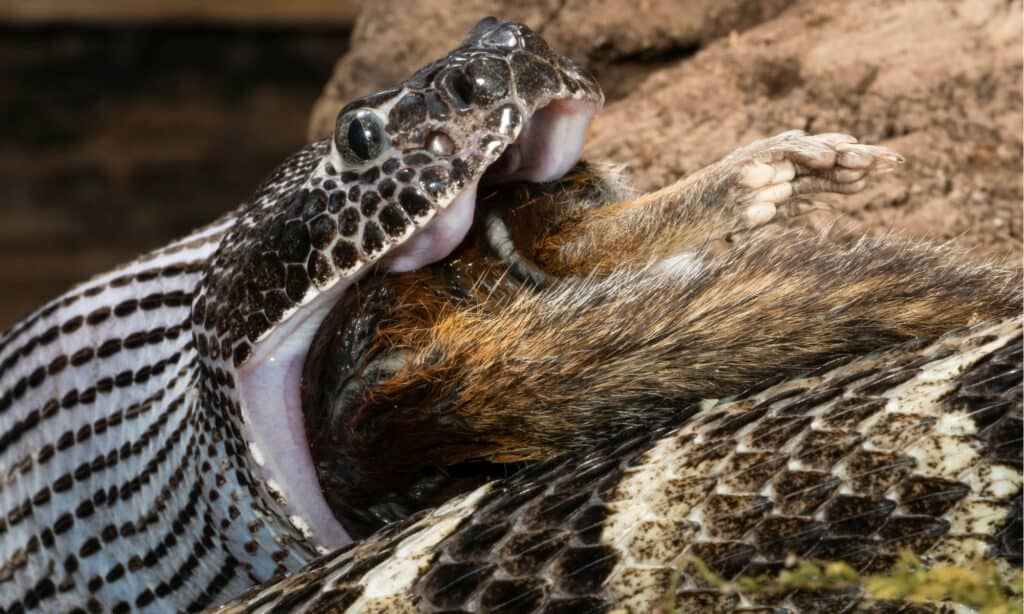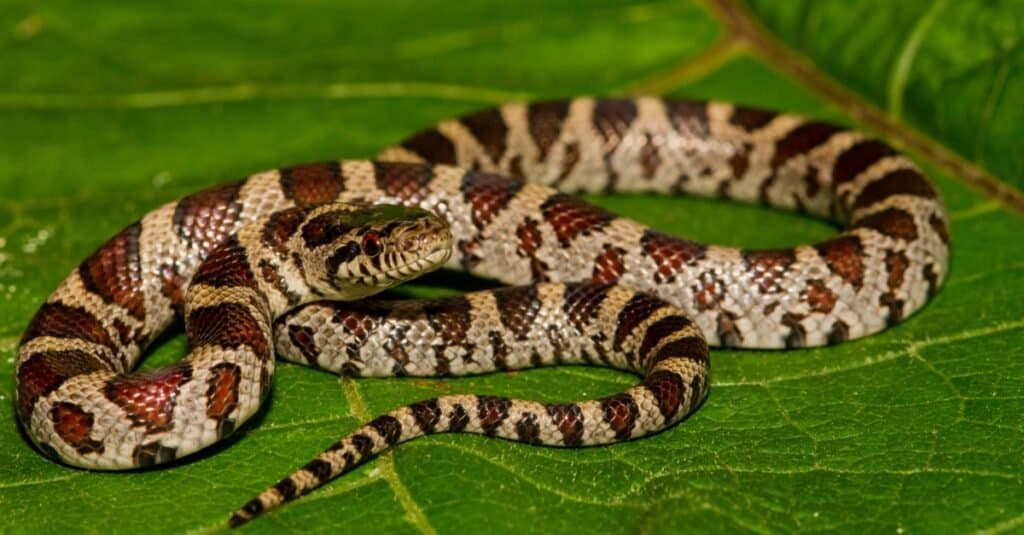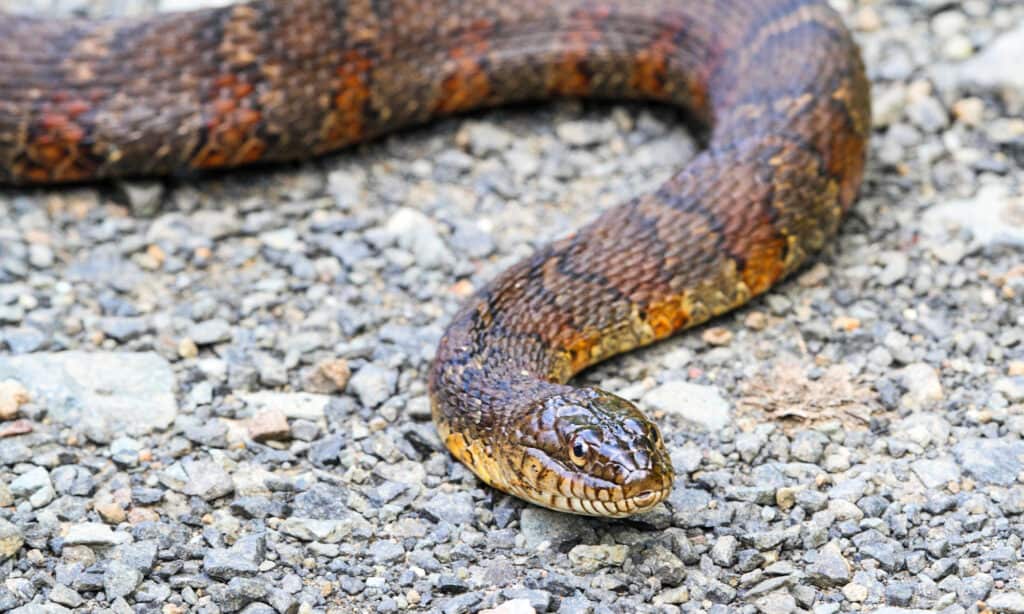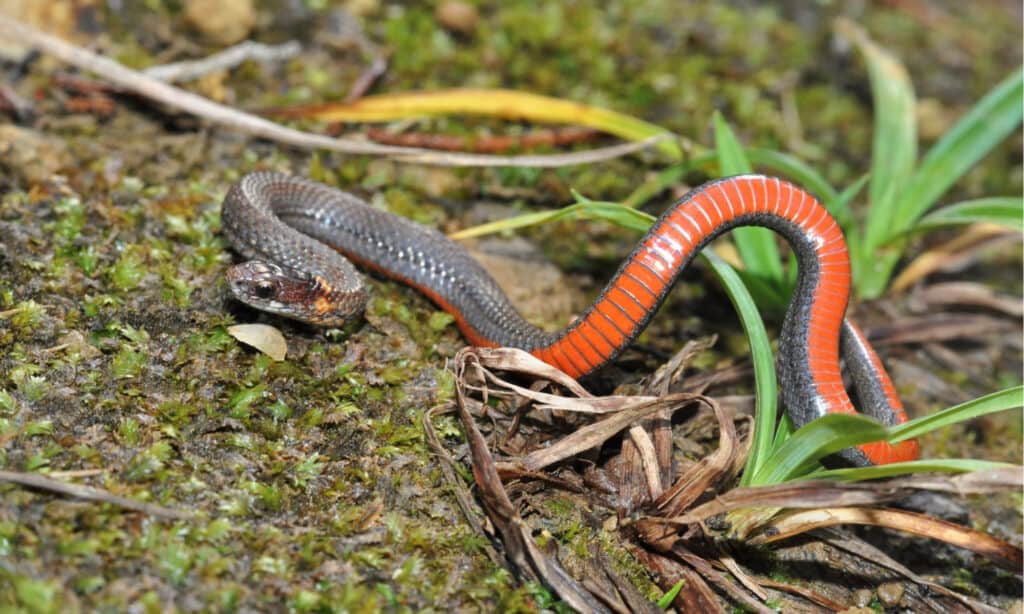Vermont is a beautiful state in the New England region of the United States with rugged mountains, open country, forests, and lakes. It is an excellent getaway for travelers who enjoy hiking, fishing, and other outdoor activities. However, its cold climate is not quite as appealing to snakes. Vermont is home to only a dozen or so species of snakes, and only one type is venomous. Let’s take a closer look at the only rattlesnake in Vermont, the timber rattlesnake!
The Timber Rattlesnake

iStock.com/NajaShots
In Vermont, there used to be a bounty on timber rattlesnakes. Up until 1971, people were paid for turning in snakes. However, now they are an endangered species and are protected by state laws, which means we have to be careful not to hurt or kill them. Vermont’s Wildlife Action Plan also lists them as a high priority Species of Greatest Conservation Need.
If you see a timber rattlesnake in Vermont, the state department asks that you please take a picture and report the sighting to help with conservation efforts. Timber rattlesnakes live in places like rock slides and ledges, and in woods with lots of oak and hickory trees. However, there are very few timber rattlesnakes left in the state along the west-central edge of Vermont. They like the rugged terrain in the area, particularly in Rutland County.
In addition to human persecution, habitat loss, and snake fungal disease, one of the challenges for timber rattlesnake populations is that these snakes have a slow life process. Population turnovers take a long time, as males do not reach sexual maturity until they are four to seven years old, and females do not reach sexual maturity until they are six to eleven years old. In addition, female snakes only produce every three to five years. While they can live for 20-25 years in the wild, a single female timber rattlesnake will only give birth to three to five litters in her lifetime (with four to 10 babies in each litter).
Timber Rattlesnake Appearance

Joe McDonald/Shutterstock.com
Timber rattlesnakes possess dark brown, yellow, or tan bodies that are thick and heavy, with dark V-shaped or W-shaped band patterns. In Vermont, they typically grow between 24-48 inches long, although the longest timber rattlesnake in the state was 54 inches. Their bodies are covered in heavily keeled scales, which means there is a textured ridge running down the middle of each scale. In Vermont, there are typically two different color morphs of timber rattlesnakes. The first have yellow heads, with bright colors and patterns, and the other ones have black heads with dark colors and patterns. Some snakes may be almost completely black as well.
The end of a timber rattlesnake’s tail is black and tipped with a large yellowish-tan rattle. The rattle is made of keratin, the same substance as human hair and fingernails. When the snake is threatened, it shakes its rattle to make a noise. However, much of the time, timber rattlesnakes will rely instead on their camouflage colors to keep them hidden, as they are not aggressive and avoid conflict whenever possible. In addition, rattles can break off and regrow over time, and baby rattlesnakes only have small buttons.
Timber Rattlesnake Behavior
Timber rattlesnakes typically live alone, although they do group together in dens to brumate through the winter. They are ambush predators and eat mammals like cottontail rabbits, shrews, voles, mice, squirrels, and chipmunks. Timber rattlesnakes climb trees with great skill and are active at night and during the day. However, they spend most of their time basking in the sun or waiting for their food to come to them.
While these snakes have venomous bites that are very dangerous, you don’t have to worry about them in Vermont. Not only are they rare, but timber rattlesnakes are also very shy and not at all aggressive. In fact, in the past 50 years or so, there has only been one rattlesnake bite, which occurred because someone was trying to handle the snake.
Other Snakes in Vermont
While there is only one venomous rattlesnake species in Vermont, there are several other harmless snakes that make their homes here. Here are a few examples of the most common snakes that you might encounter while hiking through the state’s beautiful mountains and open country.
Eastern Milk Snake

Jay Ondreicka/Shutterstock.com
Although they may look dangerous, eastern milk snakes are nonvenomous and pose absolutely no danger to humans! The colors and patterns of these snakes mimic venomous coral snakes as a defensive measure, but milk snakes are completely harmless. Milk snakes in Vermont are quite common, often found in farms, fields, stone walls, old buildings, and forests around the state. They typically grow to around three feet in length. The longest milk snake recorded in Vermont was 43 inches. Eastern milk snakes are colorful snakes that have reddish-brown blotches with black outlines that darken as they get older. There is also a white “Y” pattern on the top back of their heads, and their bellies have a black and white checkerboard-like pattern.
Northern Water Snake

Steve Byland/Shutterstock.com
Northern water snakes are common in Vermont (although there are fewer of them in the northeastern regions of the state), and they like to live near water sources like rivers and streams. They enjoy basking in the sun and eating prey. Sometimes they go on land, but never too far from the water. Northern water snakes are dark-colored snakes that grow between 24-55 inches in length. They can be brown, tan, or gray, with a series of square blotches that may merge to form bands. Their bellies are usually orange, yellow, or white, with dark half-moon-shaped edges. Juveniles have reddish-brown saddles on a gray, brown, or tan background.
Common Garter Snake

iStock.com/Wildnerdpix
Common garter snakes live all over the state of Vermont. The habitats that these snakes can live in vary a lot, but it is often found near water. These snakes are mostly active during the day, but they can tolerate a much wider range of temperatures than other snakes. Garter snakes come in many colors and patterns, but they typically have dark bodies, with a yellow stripe running down each side, and one running down the middle of their backs. They grow between 16-42 inches long. Although they are not dangerous to humans, garter snakes can bite, and they have slightly toxic saliva that can cause minor irritation and swelling.
Red-Bellied Snake

Mike Wilhelm/Shutterstock.com
Red-bellied snakes are small, thin snakes that are common all over Vermont. They are mostly found in woods that have a lot of trees that lose their leaves in the fall. These snakes like it to be moist and cool, and they often hide under things like bark, logs, rocks, and leaves. They can also be found in drier places like pastures and grasslands next to woods. Sometimes, they are seen in the open sun, and sometimes they climb into low shrubs. Red-bellied snakes are usually brown, black, or gray. Their bellies are a bright and vibrant red, although occasionally, they are pink, pale yellow, and orange. On very rare occasions, red-bellied snakes may even have a black or gray belly. They are the smallest snakes in Vermont and only grow eight to 16 inches long.
Up Next:
- 11 Snakes in Vermont
- Why Do Rattlesnakes Have a Rattle on Their Tails?
- Viper Pits: The Incredible “Sixth Sense” that Lets Vipers Hunt in Infrared
The post Discover Vermont’s Only Rattlesnake Species appeared first on AZ Animals.
from Animal News, Facts, Rankings, and More! - AZ Animals https://ift.tt/xGXvK69